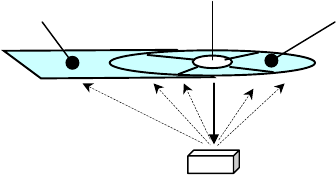
3.5.1
3 - 33
3.5.1.2 Backscattered Electron Detector (BSE)
For conducting observations, a backscattered electron detector is normally used in the low-
vacuum mode.
The backscattered electron detector picks up the electrons reflected from the specimen by
means of a semiconductor sensor attached to the underside of the objective lens. The
semiconductor sensor is comprised of a doughnut-shaped 4-way split element that has a hole
through which the primary electron beam can pass, and a 3D imaging sensor that detects low-
angle reflection electrons. By putting detected signals through computational processing, the
semiconductor sensor provides image observations in three detection modes: composition
(COMP), topology (TOPO), and stereo (3D) modes.
Fig. 3.5-3 Signal Detection by Backscattered Electron Detector
BSE
Primary electron beam
S
p
ecimen
3D imaging semiconductor element
4-way split semiconductor element


















